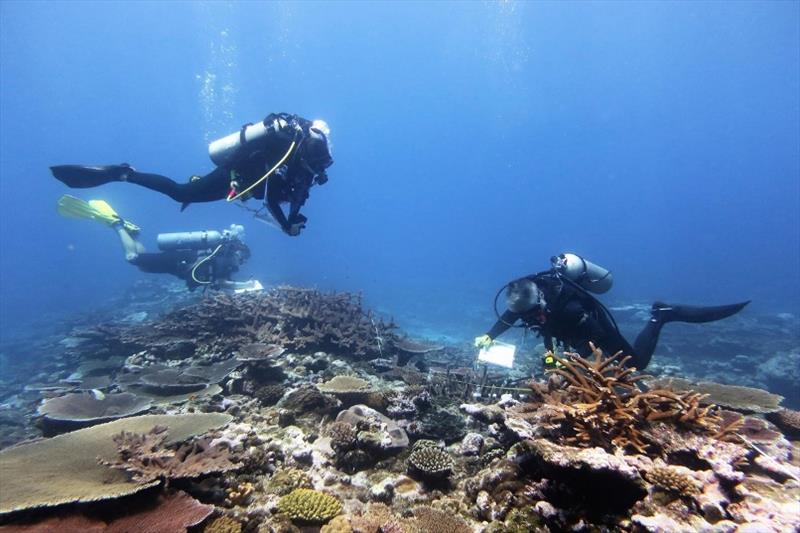
Hope for coral reef recovery in American Samoa? Preliminary observations from the field
by Morgan Winston, NOAA Fisheries 6 Mar 2020 13:19 UTC

NOAA divers identify and measure coral colonies along a transect in Vatia's outer bay while American Samoa Department of Land and Natural Resources and National Marine Sanctuaries divers observe the survey methods © NOAA Fisheries / Morgan Winston
For three weeks in January, we conducted coral reef surveys in Vatia Bay and Faga'alu Bay on the island of Tutuila, American Samoa. Our small but mighty team collected data on coral condition and benthic community composition at 60 sites.
A fundamental part of our mission was to help local and federal agencies in American Samoa continue coral reef monitoring surveys in the future. We devoted several days to training our partners from the American Samoa Department of Marine & Wildlife Coral Reef Advisory Group and the National Marine Sanctuary of American Samoa in our benthic survey methods.
Now that we are back in the office on O'ahu, we're digging into the data to see if management actions to reduce land-based sources of pollution have had observable effects on the coral communities.
General trends in coral reef communities
In the inner-bay sites of both Vatia Bay and Faga'alu Bay, we observed high levels of turbidity and sedimentation stress. Visibility tended to be quite poor at our shallow and near-shore sites, where the reefs have been most affected by terrigenous runoff, sedimentation, and turbidity in the past.
The outer-bay sites had comparatively clearer water and the coral community appeared healthier and more diverse. We observed more coral species in Vatia Bay than Faga'alu Bay.
We hoped to see signs of recovery in Faga'alu Bay following the 2014 management actions to reduce nutrient and sediment runoff. In the shallow, northern forereef, we noticed evidence of improvement—the corals are growing here again! Even in the backreef of Faga'alu, there appeared to be an increase in coral cover.
We will process our data over the next few months to see if these in-water observations are reflected in our quantitative statistical results. We will also explore changes over time in benthic cover, adult and juvenile coral density, coral partial mortality, and coral biodiversity.
Coastal runoff and increased nutrient inputs appear to impact Vatia Bay as a continued result of poor nearshore land use practices and wastewater management. However, until we finish our data analysis, it is too soon to draw conclusive trends about changes in the coral communities over time.
Macroalgae and corallimorph overgrowth
In both bays, the persistence of macroalgae such as Dictyota, Valonia, Peyssonalia and Halimeda suggests nutrients are fueling their growth. Such nutrients are likely coming from land.
We also spotted the invasive corallimorph Rhodactis howesii at several of our mid-depth sites in Vatia. Rhodactis is a highly poisonous, defiant competitor for space, easily overgrowing and displacing scleractinian corals.
Under the right conditions, it can become pervasive—we have seen this in the Pacific Remote Islands Marine National Monument at Palmyra Atoll and Howland Island. Research implicates iron leachate from shipwrecks and metallic debris in promoting Rhodactis proliferation.
Resilient corals
During our first dive in the inner-bay at Vatia, where visibility was less than 15 feet, we encountered a massive Porites lobata colony. It sat approximately 13 feet wide (4 m diameter) and nearly 10 feet tall (3m height) in the middle of the murky water.
At first glance, the colony appeared mostly dead and overgrown with algae. Surprisingly, closer inspection revealed that the colony surface was carpeted with a thin layer of mucous that trapped sediment and particles.
As the mucous sheet peeled off, healthy coral tissue was revealed underneath—a remarkable adaptation that has allowed this goliath to survive years, if not decades, of sedimentation. As it turns out, more than 80 percent of this large colony surface was alive!
The ability of Porites to produce mucous sheets to shed off excess sediments in response to sediment stress has been observed before. Indeed, mucous sheet prevalence may prove to be an effective bioindicator of sediment exposure.
Our mission for building capacity and strengthening partnerships
After the three days of classroom and in-water reef sampling training, some of our partners joined us for several surveys at Faga'alu and Vatia. They will implement a variation of our method in their own coral surveys to come. We also provided them with a new geographic information systems tool to help visualize how human and environmental stressors affect nearshore reefs around Tutuila.
Continuing the conservation effort and success in American Samoa
The mitigation efforts conducted in 2014 to reduce sediment loading into Faga'alu Bay were a meaningful management action. Still, local resource management agencies, stakeholders, and community members have much work to do.
Conservation and recovery of these long-impacted coral reef systems necessitate sustained efforts and resources. Our team is excited to offer continued support to this long-term management effort.